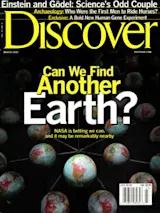The infant Earth was a harsh place for life to begin. The oceans were covered with ice, the climate was as forbidding as modern Antarctica. And every few tens of millions of years, giant asteroids barreled into the planet, boiling away the oceans and veiling the globe with clouds of vaporized rock. Each impact would have sterilized the surface, yet evidence shows life survived the bombardment. Geophysicist Norman Sleep of Stanford University theorizes that early organisms endured in an unusual sanctuary—deep underground or out in space—and repopulated the surface when conditions improved.
Studies of lunar craters indicate Earth was struck by 15 to 20 huge asteroids, each about 150 miles wide, between 4.5 billion and 3.8 billion years ago, when the first solid evidence of life appears. But Sleep's research reveals that chemical conditions below Earth's surface were suitable for heat-loving microbes that derive energy from hydrogen and methane. Called ...














